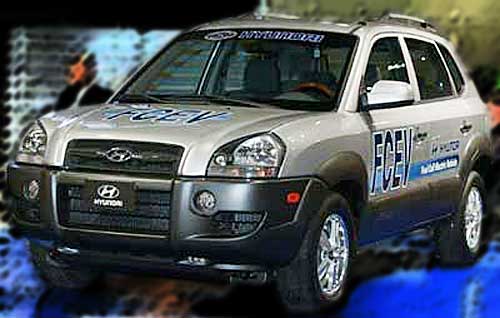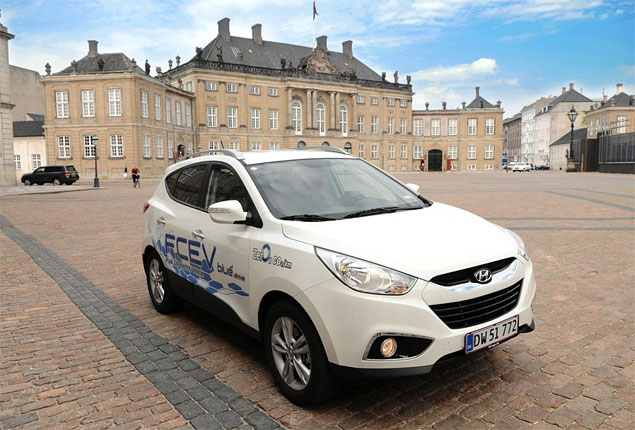Hyundai Tucson Hybrid FCEV
The Hyundai Tucson Hybrid FCEV (Fuel Cell Electric Vehicle) is a second-generation hydrogen vehicle based on its Tucson small SUV. The first generation hydrogen vehicle was the Hyundai Sante Fe FCEV, which was developed and demonstrated in the year 2000.
 |
The Hyundai Tucson Hybrid FCEV has an extended driving range (186 miles), more top end speed (93 mph) and greater cold start capacity (-20 Celsius when sitting idle for 5 days) than the Sante Fe FCEV. By comparison, the Sante Fe FCEV comes with a range of approximately 90 miles, top speed of 77 mph and no real cold cranking power of which to speak. The Hyundai Tucson Hybrid FCEV also gets 80 kw of power from its new electric motors compared to the Sante Fe FCEV’s 75 kw motors.
The fuel cell system including drivetrain and hybrid battery are located in the Hyundai Tucson FCEV in such a way as to retain interior space and cargo capacity. The power plant, including fuel cell stack is located under the hood and the new lithium ion polymer battery pack is located in the spare tire wheel well. All crash test safety standards were met and the Tucson FCEV even showed better side-impact crash performance than the standard Tucson SUV.
The Hyundai Tucson Hybrid FCEV was built using lightweight, high-performance aluminum body components, making it slightly lighter than its predecessor, while increasing safety. The 40 gallon compressed hydrogen tanks were built by Dynetek Industries Ltd. of Calgary, Alberta, Canada. The fuel cells stack was developed by UTC Fuel Cells of South Windsor, Connecticut, USA. The next generation hybrid-electric drive train, motor and control unit were developed by Enova Systems, of Torrance, California. Hyundai Motor Co. and LG Chem in Seoul, Korea co-developed the 152-V high voltage battery pack.
The next step for Hyundai is fleet testing of its hydrogen vehicles. On December 14, 2005, Hyundai has delivered the first two of the eventual 10 Hyundai and Kia Sportage FCEV SUVs to the Alameda-Contra Costa Transit District (AC Transit). This marks the beginning of a five-year demonstration and validation project designed to evaluate hydrogen vehicles and infrastructure.
In April 2004, the Department of Energy awarded Hyundai, Chevron Corporation and UTC Power a federal grant to research hydrogen-powered fuel cell technology. In Chino, California, Chevron opened its first-ever hydrogen energy station at the Hyundai America Technical Center (HATCI). Fleet vehicles also are planned for the Southern California Edison utility company (Rosemead, California) and the U.S. Army facilities in Detroit.

Hyundai ix35 Tucson FCEV
In 2010, the Hyundai Tucson ix35 hydrogen fuel cell vehicle was introduced. With a 360 mile plus range and 100 mph top speed, this has been a sorely needed upgrade since the older model was introduced in 2004. The Hyundai Tucson ix35 FCV will most likely rollout in the 1,000’s in 2012 along the South Korean Hydrogen Highway system and the European Union Hydrogen Highway system.